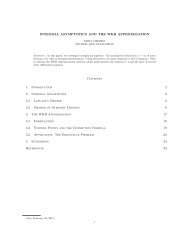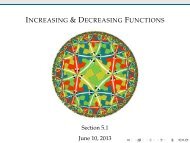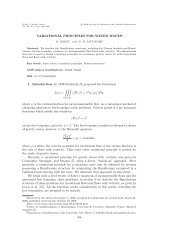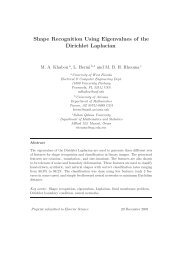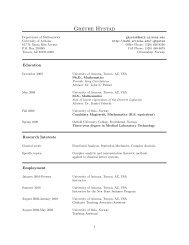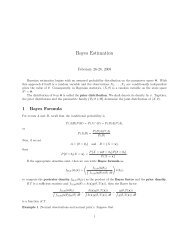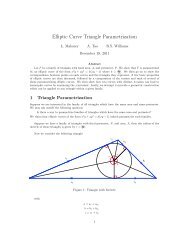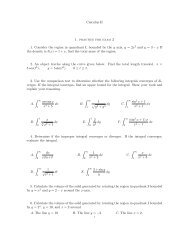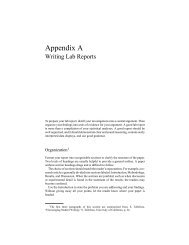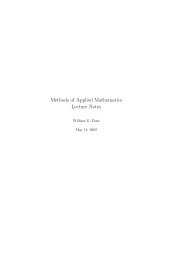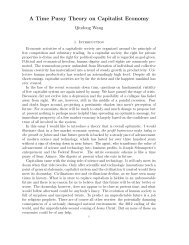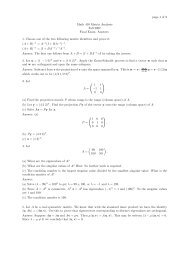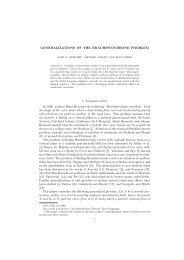Lectures on Elementary Probability
Lectures on Elementary Probability
Lectures on Elementary Probability
Create successful ePaper yourself
Turn your PDF publications into a flip-book with our unique Google optimized e-Paper software.
2.7. DIVISIONS INTO SUBSETS 15<br />
players, each of whom gets 13 cards. So the occupati<strong>on</strong> numbers are 13, 13, 13,<br />
13.<br />
There are alternative of thinking of this. We can think of taking the subsets<br />
in order and then selecting the elements of each subset in order. The number<br />
of ordered divisi<strong>on</strong>s into labeled subsets is<br />
(n) n1 (n − n 1 ) n2 (n − n 1 − n 2 ) n3 · · · (n − n 1 − · · · − n m−1 ) nm = n! (2.21)<br />
This says that if you select in order all elements of I that go in the first subset,<br />
then those that go in the sec<strong>on</strong>d subset, and so <strong>on</strong>, this is just the same as<br />
selecting all the elements of I in order. In the card example this is the (52)!<br />
ways of dealing the cards.<br />
If we take the subsets in order, but then neglect the order within each subset,<br />
then we get the divisi<strong>on</strong> into labeled subsets. The number of such divisi<strong>on</strong>s into<br />
labeled subsets is<br />
( )( )( ) ( ) (<br />
n n − n1 n − n1 − n 2 n − n1 − · · · − n m−1<br />
· · ·<br />
=<br />
n 1 n 2 n 3 n m<br />
)<br />
n<br />
.<br />
n 1 , n 2 , · · · , n m<br />
(2.22)<br />
This says that if you select the first subset, then the next subset, and so <strong>on</strong>,<br />
this generates the entire divisi<strong>on</strong>. The number of such divisi<strong>on</strong>s is given by<br />
the multinomial coefficient. It is the number of functi<strong>on</strong>s from I to M with<br />
given occupati<strong>on</strong> numbers, but thought of as ways of dividing up I. In the<br />
card example this is the ( 52<br />
13,13,13,13)<br />
ways choosing a subset of 13 cards for each<br />
player.<br />
C<strong>on</strong>sider the case when all the occupati<strong>on</strong> numbers are equal. Then there is<br />
even a third way of thinking of this, where we forget about the labels. That is,<br />
we think of the n element set I and of m subsets, each with the given number<br />
n 1 of elements, so that n = mn 1 . This neglects the order in which the sets are<br />
taken as well as neglecting the order within each subset. The number of such<br />
divisi<strong>on</strong>s into unlabeled subsets is then<br />
1<br />
m!<br />
(<br />
)<br />
n<br />
. (2.23)<br />
n 1 , n 1 , · · · , n 1<br />
(<br />
52<br />
13,13,13,13)<br />
ways making four piles of 13 cards<br />
In the card example this is the 1 4!<br />
without specifying an order for the piles.<br />
Some problems can be solved with any <strong>on</strong>e of the three points of view. For<br />
instance, take the problem of finding the probability that all the spades go to<br />
<strong>on</strong>e of the players (the player not specified).<br />
1. From the ordered point of view, this is 4(13)!(39)! divided by (52)!. This<br />
is because there are (13)! ways the spades can be dealt to a specified player and<br />
(39)! ways the remaining cards can be dealt to the other three players. There<br />
are 4 ways to specify the player.<br />
2. From the divisi<strong>on</strong> into labeled subsets point of view, this is 4 ( 39<br />
13,13,13<br />
)<br />
divided by ( 52<br />
13,13,13,13)<br />
. This is because there is <strong>on</strong>ly <strong>on</strong>e way to give the spades<br />
to a specified player, and there are ( 39<br />
13,13,13)<br />
ways the remaining cards may be



